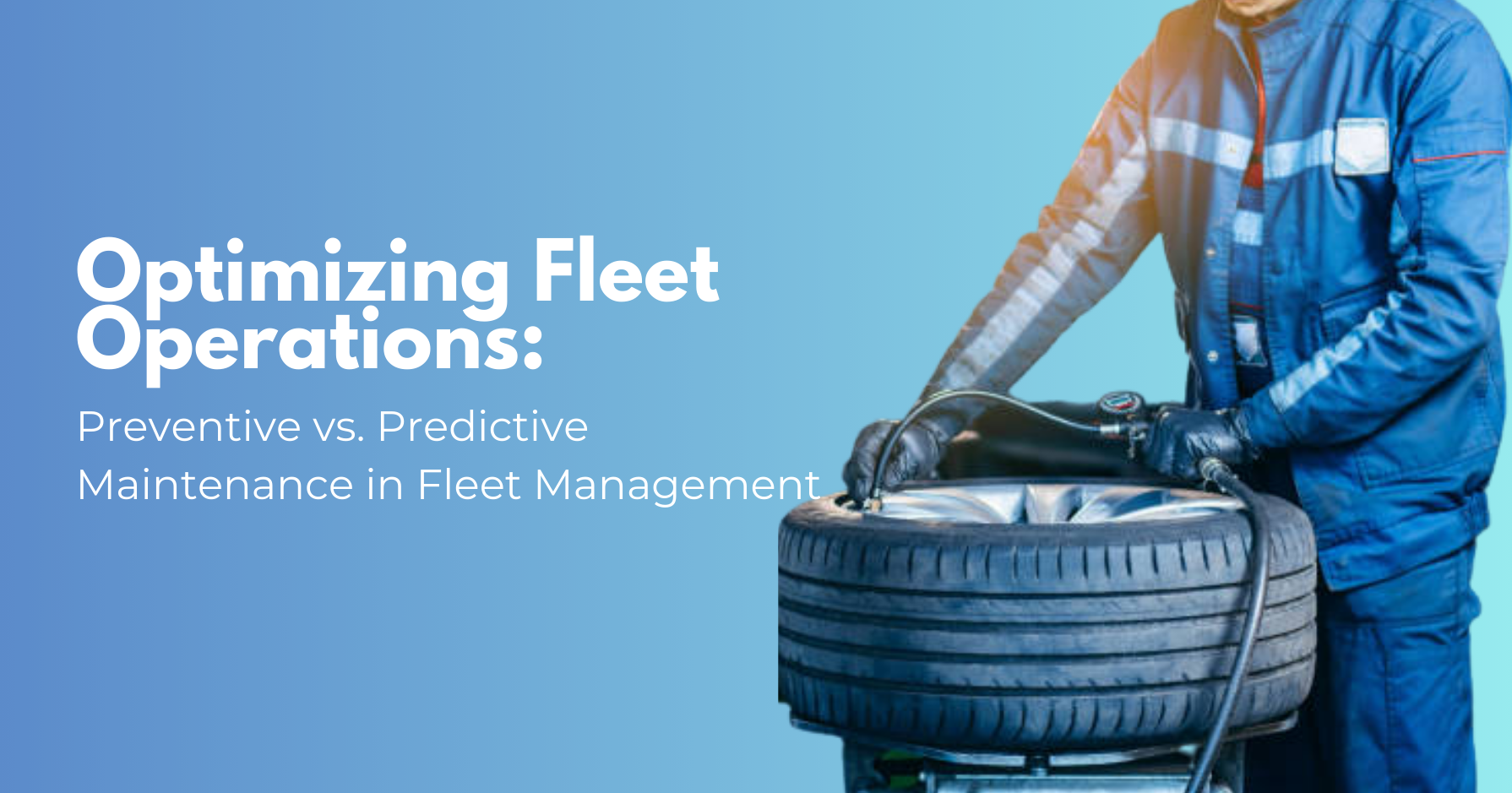Table of Contents
Introduction
The Fleet Management Industry has continuously had the need for cost-efficient strategies to keep vehicles in the best conditions and boost their longevity. This gave rise to two reliable strategies; Preventive Maintenance and Predictive Maintenance. However, there are key differences between these two approaches and their application in Fleet management. In this article, we will be looking at these differences, the benefits of both approaches and their examples in fleet management.

What is Preventive Maintenance?
Just as the name implies, Preventive Maintenance (PM) is staying ahead of potential vehicular issues. It is the practice of performing maintenance on fleets in order to reduce the risk of fleet failings and unexpected breakdowns. Preventive Management involves a strategic approach that aims to minimize downtime, reduce operational costs, and enhance the overall longevity of your fleet. Relying on PMs allows you to focus on maintaining your fleets proactively instead of maintaining them reactively.
What is Predictive Maintenance?
Predictive Maintenance (PdM) relies on real-time data and data analysis tools to identify potential faults in fleets and forecast when maintenance will be needed. It employs sensors, telematics, and predictive algorithms to monitor the condition of vehicles and predict failures before they occur. The main goal of predictive maintenance is to reduce the frequency of unplanned reactive maintenance while avoiding excessive costs linked to preventive maintenance. Finding a balance between preventing failures and avoiding unnecessary maintenance activities can be done by strategically planning maintenance activities.
Benefits of Preventive Maintenance in fleet operations
There are several benefits of preventive maintenance which will help the longevity of your fleet.
1. Cost Efficiency:
Preventive maintenance helps you identify and fix problems before they become costly breakdowns. By replacing worn-out parts or addressing minor issues early, you can avoid major repairs that could be expensive and as such, properly optimize your budget.
2. Extended Vehicle Lifespan:
Regular maintenance prolongs the life of your fleet vehicles, saving you the substantial expense of replacing them frequently.
3. Downtime Minimization:
One of the most profitable advantages of preventive maintenance is the substantial reduction in downtime. Regular inspections and proactive servicing ensures that minor issues are addressed before they escalate into major problems.
4. Safety:
Frequent Preventive Maintenance ensures your fleet vehicles are in top condition which is crucial for the safety of both drivers and other road users. Regular maintenance reduces the risk of accidents or breakdowns caused by mechanical failures.
5. Regulatory Compliance:
Many regulations require commercial vehicles to undergo regular inspections and maintenance. Adhering to these regulations can be streamlined through consistent preventive maintenance, helping you avoid fines, penalties, and legal complications.
Benefits of Predictive Maintenance in fleet operations
Here are some benefits of predictive maintenance that help you take precautionary actions on your fleets to avoid potential harmful damages.
1. Enhanced Reliability:
Predictive maintenance maximizes the reliability of your fleet, reducing unscheduled downtime by identifying potential issues before they eventually happen, thereby giving you fore knowledge of a potentially threatening damage to your fleet.
2. Optimized Operations:
Having insights into the health of your vehicles, can enable you to effectively plan routes, assignments, and maintenance schedules. This gives your vehicles the leverage to totally avoid situations that could pose damages to the fleet.
3. Increased Uptime:
Identifying potential problems in advance, helps you make informed decisions that can keep your vehicles on the road, improving your fleet’s overall productivity.
4. Enhanced Safety:
Predictive maintenance ensures that your fleet is in top-notch condition, reducing the risk of accidents due to mechanical failures as potential problems can be easily detected and adequately handled, ensuring the safety of your fleet.
5. Optimized Scheduling:
Predictive maintenance enables you to plan maintenance activities when needed, minimize disruption to your operations, improve efficiency and reduce operational costs.
Examples of Preventive Maintenance in Fleet Management
Some examples of preventive maintenance program your fleet could implement
1. Scheduled Oil Changes:
In order to prevent wear and tear caused by friction, fleets should be lubricated regularly. Regular greasing and oil changes will keep the vehicle’s part moving smoothly thereby reducing the rate of repairs.
2. Air Filter Replacement:
Blocked air filters prevent car engines from receiving the much needed airstream which results in reduced fuel efficiency, greater emissions and shorter engine life. Extremely dirty or damaged filters should be replaced immediately to avoid damage to vehicle engines.
3. Brake Inspections:
As far as safety is concerned, an unreliable brake breeds danger for driver and other road users and as such, periodic brake checks becomes a necessity. Brake pads and Brake fluids on the fleet should be properly inspected and quick action taken if a fault is spotted to ensure safety of the vehicle and driver.
4. Electrical System Inspection:
Vehicles rely on their electric systems for almost everything. Ensuring all lights, indicators, and battery connections are in working order will prevent unexpected electrical failures.
5. Cleaning of HVAC systems:
Accumulated dirt and dust within a vehicle’s HVAC system can lead to electrical system issues and undue engine failure. Fleets can regularly inspect their vehicle HVAC systems and clean them in intervals. Light cleanings can be done using a can of compressed air and some rags while more thorough and deep cleanings may involve removing parts of the HVAC system to flush hoses and reach more difficult spots.
Examples of Predictive Maintenance in Fleet Management
Here are some examples of predictive maintenance that have been implemented overtime in fleet management
- Delivery companies employ predictive maintenance software to analyze fleet’s data, helping them predict tire wear, that way, they proactively replace tires, reducing the risk of blowouts and delivery delays.
- A public transportation agency can make use of predictive maintenance AI models to predict maintenance needs. This ensures that buses are always in good condition, minimizing service disruptions for commuters.
- Logistics companies integrate telematics and predictive maintenance AI to monitor trucks’ health. This allows them to address potential issues adequately before they escalate, leading to increased efficiency and customer satisfaction.
- Airlines use predictive maintenance to forecast component failures in their aircraft, ensuring passenger safety and minimizing flight delays.
Types of Preventive Maintenance Services
To keep fleets in good condition, certain preventive maintenance services need to be performed on a regular basis. Here are a few:
1. Scheduled Inspections:
Regular maintenance schedules based on mileage, time, or usage has to be set up to catch issues before they escalate.
2. Diagnostic Tools:
Certain diagnostic tools have to be used to identify potential problems, even those that might not be visible to the naked eye.
3. Fluid Replacement:
Oils, fluids, and filters would be changed regularly following manufacturer guidelines to keep the engine running smoothly.
4. Component Lubrication:
Moving parts should be properly lubricated to reduce friction and wear, prolong the life of critical components.
Types of Predictive Maintenance Services
To successfully implement predictive maintenance, you would need to consider these predictive maintenance services;
1. Data Analysis:
Employing the services of experts who can analyze your fleet’s data to identify trends and predict maintenance needs accurately helps protect your fleets from mechanical failures and cost of expensive repairs to severe damages.
2. Sensor Installation:
It is imperative to have professional installation of sensors on vehicles to enable real-time data collection. This data enables you to make informed decisions regarding your fleet’s components and what measures should be taken to forestall critical damages that might occur.
3. Alert Management:
Adequate monitoring and management of predictive maintenance alerts ensures timely responses to issues before they escalate.

Preventive Maintenance Checklist
A preventive maintenance checklist involves the actions you need to take on your fleet to ensure they remain in good working conditions to allow for smooth service delivery. A typical preventive maintenance checklist would include:
Fluid Checks
Tire Maintenance
Brake Inspections
Electrical System Checks
Engine Health Check
Air filter check
Routine Inspections
Scheduled Oil Changes
Exhaust System Inspections
Battery Health Monitoring
Suspension and Steering Component Checks
Emergency Equipment Verification.
Predictive Maintenance Checklist
Having a predictive maintenance checklist enables you to have knowledge of future damages that might occur on your fleets so as to take adequate measures to avoid them. A predictive maintenance checklist would include:
Data Collection
Advanced Data Analysis
Predictive Models
Maintenance Triggers
Monitoring Parameters.
Preventive Maintenance vs Predictive Maintenance
The table below shows key differences between preventive fleet maintenance and predictive fleet maintenance
| Preventive Fleet Maintenance | Predictive Fleet Maintenance |
|---|---|
| Scheduled, routine maintenance tasks | Real-time data analysis and forecasting |
| Preventing breakdowns | Predicting failures before they occur |
| Time-based or usage-based | Data-driven and condition-based |
| Historical maintenance schedules | Real-time sensor and IoT data |
| Fixed intervals | As issues are predicted |
| Not so effective in reducing downtime | Highly effective in reducing downtime |
| May sometimes lead to unnecessary replacements | Minimizes costs by addressing issues early and ensuring only necessary replacements are made |
| Less complex and easier to implement | Requires advanced analytics and AI |
| Less accurate in predicting failures | Highly accurate due to real-time data |
| Offers basic monitoring of components | Offers In-depth monitoring with sensor data |
| Routine oil changes and tire rotations | Brake wear prediction and timely repairs |
IoT Preventive Maintenance vs IoT Predictive Maintenance
The Internet of things (IoT) has played a vital role in Fleet maintenance for both Preventive Maintenance and Predictive Maintenance
1. IoT Preventive Maintenance
IoT Preventive Maintenance involves the use of sensors and connected devices to monitor vehicle performance in real-time. It mostly relies on predetermined thresholds and schedules before maintenance tasks are implemented. IoT preventive maintenance would typically involve;
i. Scheduled Checkups:
Regularly conducting maintenance based on predetermined schedules.
ii. Scheduled Data Collection:
Collecting data from vehicles at fixed intervals.
2. IoT Predictive Maintenance
IoT Predictive Maintenance leverages real-time data from IoT sensors to predict when maintenance is required. It identifies trends and anomalies in vehicle data to anticipate issues. This minimizes human intervention and maximizes the precision of maintenance actions. IoT Predictive maintenance involves;
i. Real-Time Data:
Collecting data in real time from IoT devices.
ii. Anomaly Detection:
Using AI to identify anomalies and predict potential failures.
iii. On-Demand Maintenance:
Performing maintenance only when data suggests a need.

Predictive Maintenance in Vehicles
Modern vehicles are equipped with advanced diagnostics systems that collect data on various components like engine performance, tire pressure, and emissions. This data allows fleet managers to anticipate maintenance needs accurately. Predictive maintenance in vehicles aids fleets to keep the following in check:
1. Engine Health:
Predictive maintenance can anticipate engine issues, prompting timely repairs or component replacements.
2. Transmission Performance:
Monitoring transmission health prevents unexpected breakdowns and disruptions.
3. Brake System Optimization:
Sensors can predict brake wear, ensuring that maintenance is performed before safety is compromised.
Predictive Maintenance Challenges
As much as predictive maintenance offers a host of benefits to fleets and has a huge advantage it’s not without its challenges:
1. Data Quality:
Reliable predictions depend on high-quality and accurate data. Poor data can lead to erroneous conclusions thereby causing harm to fleets.
2. Implementation Complexity:
Integrating predictive maintenance systems requires technical expertise and a solid implementation strategy.
3. Change Management:
Shifting from reactive to predictive maintenance requires some level cultural and organizational adjustments as certain systems would be changed and the fleet managers would have to adapt to these changes.
4. Initial Investment:
Implementing predictive maintenance systems can be costly at the initial implementation, but it is an investment worth making as it proves to be a cost efficient strategy in the long run, saving your fleet from severe damages.
Conclusion
Preventive maintenance has proven overtime to be reliable to a certain extent, predictive maintenance has become more and more required to predict potential damages that could pose serious threats to fleet vehicles. These threats may oftentimes be missed out through preventive maintenance as it has its limitations, leading to unplanned maintenance and budget overrun as more funds would be allocated to repair such damages.
Not every organization might be able to implement predictive maintenance, however, larger organizations that have outgrown the limitations of preventive maintenance approaches, predictive maintenance can offer a return on investment by saving unwarranted repairs to fleet components, thereby saving cost and increasing profitability.
Instanta Fleet Management Software, offers organizations the opportunity to try out both Preventive and Predictive maintenance strategies to keep their fleets out of harm’s way and enjoy profitable return on investment as fleet managers would no longer have to rely on traditional maintenance which is increasingly becoming unreliable in Fleet management.
You can schedule a Demo to try out Instanta Fleet Management Software and see how best it helps keep your fleet running in the best condition.





















